Introduction
Like insects, earthworms (Figure 1) are among the animals most frequently encountered by many Floridians. Our kids play with them (Figure 2), dissect them in middle school biology, we fish with them; they crawl across our sidewalks and live in our flower pots. Despite this, their ecological and economic importance often goes unrecognized. Earthworms have several important ecological roles. Additionally, some species are used commercially for bait, animal feed, environmental remediation, and composting.
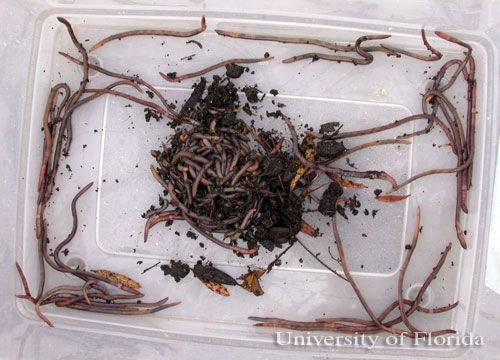
Credit: William T. Crow, UF/IFAS

Credit: Left: Emily E. Eubanks, UF/IFAS; Right: William T. Crow, UF/IFAS
The term earthworm is commonly assigned to certain worms in the class Clitellata in the phylum Annelida. Annelid worms are distinguished from other important worms like nematodes by having a coelum or true body cavity, a circulatory system, and a body divided into segments. Other familiar annelids are the Hirudinea (leeches), the Polychaeta (marine bristleworms), and the Enchytraeids (potworms). Within the order Opisthopora there are both aquatic and terrestrial species. We will use earthworm exclusively for terrestrial worms in the suborder Crassiclitellata.
Distribution
There are thousands of described species of earthworms and likely many thousands more that are yet to be described. Individual species are found in most habitats worldwide. Different earthworm species are found in natural, agricultural, and urban environments; as of the mid 1990s there were 51 earthworm species reported in Florida. The two most widely distributed wild earthworms in Florida are Amynthas corticis and A. gracilis. Some species such as Diplocardia floridana and D. mississippiensis are known to occur only in the northern portion of the state. South Florida is the only location in the United States where some tropical earthworm species such as Metaphire posthuma are found. Some earthworm species are unique to Florida, including Diplocardia alba gravida, which has only been reported in Charlotte, De Soto, and Sarasota Counties, and D. vaili, which has only been found in Liberty County. The most commonly cultivated earthworms in Florida are the tiger worm (Eisenia fetida), the red wiggler (E. andrei), and one type of nightcrawler (Dendrobaena veneta).
Morphology and Anatomy
Structurally, the first thing that is noted about earthworms is that the body is segmented, appearing as a series of aligned adjacent rings. Internally, each of these segments is separated by septa. The number of segments is fairly consistent within a species and can be useful for identification. Because the body is segmented in this fashion most earthworms can survive losing some posterior portions of their body to predation or injury, and many can regenerate the lost sections.
Moving from the anterior to the posterior, the first segment, surrounding the mouth (buccal cavity), is called the peristomium. On the peristomium is a bump or lobe called the prostomium; the shape of this feature is useful for species identification. The prostomium can be used as a flap to cover the mouth, but also has sensory functions, and can be used to grasp and draw food into the mouth. Below the peristomium is a region that, when the worm is relaxed, may be thicker than the posterior regions; this region contains the sexual organs and their related glands (Figure 3). Male and female paired genital pores on the ventral side of the body may or may not be visible to the naked eye. The next region is a smoother region on adult earthworms that may look like a saddle or belt surrounding the worm. This is called the clitellum (Figure 4) and is where the cocoon is formed.

Credit: Clive A. Edwards
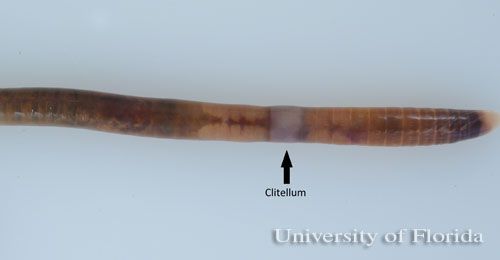
Credit: William T. Crow, UF/IFAS
The shape and number of segments making up the clitellum are mostly uniform within species and are very useful diagnostic features. Posterior from this the worm appears fairly uniform until the final segment, called the periproct, where the anus is located. Each of the earthworm's segments, except for the peristomium and the periproct, have microscopic hair-like structures called setae that can be extended or contracted and serve a variety of functions. Most setae are used in locomotion, others have tactile functions, and some aid in copulation. Earthworms move by contracting circular muscles that reduce the circumference of the individual segments while expanding them longitudinally. This is similar to squeezing a balloon in the middle and having both ends bulge out. During expansion the earthworm extends its setae to hold onto surfaces and pull the worm's body forward during contraction. This gives earthworms an expanding/contracting movement (http://www.teachertube.com/viewVideo.php?video_id=55812) unlike the sinusoidal movement of nematodes and snakes or the gliding motion of slugs and planarians.
Internally, earthworms are complex, having most major organ systems. The circulatory system consists of three major blood vessels running the length of the worm, smaller blood vessels encircling the worm, and multiple pseudo hearts that direct blood flow. The digestive system is divided into the buccal cavity (mouth), pharynx, esophagus, crop, gizzard, and intestine. While not having a true brain, earthworms have a ventral nerve cord that runs the length of the worm, a network of nerves that control the muscles, and various photo, chemo, and tactile receptors. Earthworms also have a complicated secretory/excretory system.
The respiratory system of earthworms is not advanced, and gas exchange occurs through the cuticle, which is of necessity kept moistened by secretions or "slime." Often earthworms come to the surface and migrate following rainstorms and are commonly observed on sidewalks and driveways (Figure 5). These worms die quickly when they get dry (Figure 6).
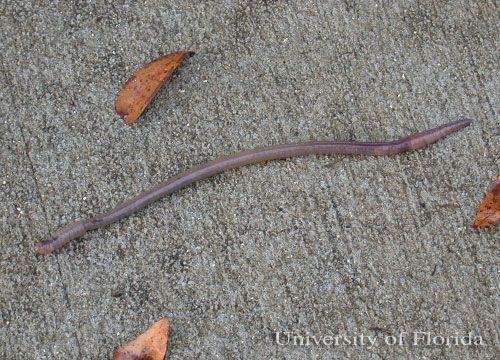
Credit: William T. Crow, UF/IFAS

Credit: William T. Crow, UF/IFAS
Life Cycle
Earthworms are hermaphroditic, adult worms having both male and female sexual organs (Figure 7). Most species copulate and reproduce by cross-fertilization, although a few species can reproduce by parthenogenesis (reproduction without fertilization). After copulation, the clitellum secretes a structure called a cocoon into which the ova and spermatozoa are deposited, and within which fertilization of the ova occurs. After the worm produces the cocoon, the cocoon hardens to give protection to the developing eggs. For most species, a single juvenile hatches per cocoon, although some species produce multiple juveniles per cocoon. Depending on the species, earthworms produce as few as one to over a hundred cocoons per year, and the cocoons can take from 3 weeks to 5 months to hatch. Most juvenile earthworms hatch with the same number of segments as they will have as an adult, the segments simply enlarging during growth. The juveniles generally look the same as adults except for the absence of reproductive organs.
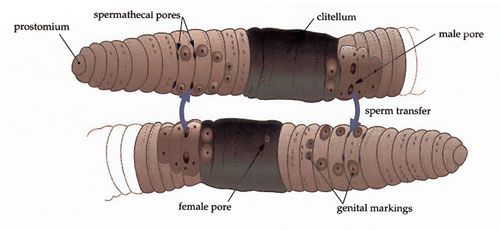
Credit: Barrie Jamieson
Earthworm species are generally categorized environmentally as being either epigeic, endogeic, and anecic. Epigeic species live in organic litter near the soil surface and generally have a short life cycle and high fecundity. Epigeic earthworms are most often used commercially for composting. Anecic species form permanant burrows, spend much of the day in the mineral horizon, but come to the surface to forage on litter and plant debris, often at night. The nightcrawlers that many are familiar with are anecic worms. Endogeic species live in the mineral soil horizons and seldom come to the surface, so these are infrequently encountered by humans. Most earthworms are omnivores, feeding on both decaying and live plant matter, fungi, bacteria, and microscopic animals. For most species, decomposing plant matter is the primary food source, although most of their nutrient needs are supplied by microorganisms ingested at the same time. The organic piles of waste left after digestion by earthworms are termed casts or castings. Epigeic worm castings can be used for compost, and anecic worm castings are often left in small piles at the surface of the worms burrow where they are commonly observed (Figure 8). Endogeic worms ingest large amounts of soil as they burrow, digest the organic matter contained therein, and then expel the mineral component back into the burrow.
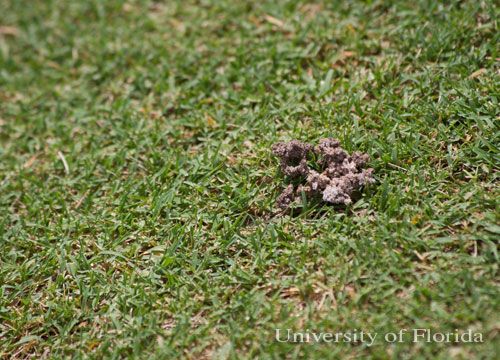
Credit: Josh Unruh, UF/IFAS
Ecological Importance
Earthworms have various important ecological roles. The most easily recognized is that of organic matter decomposition. Decomposing plant matter is ingested and then expelled in a more broken down form, greatly speeding up the decomposition process. Worm castings typically have higher microbial activity and higher concentration of plant-available nutrients than the original material and, therefore, earthworms aid in nutrient cycling. Additionally, activity of anecic worms moves organic matter from the soil surface deeper into the soil profile. Tunneling by earthworms helps break compaction, which improves aeration and water infiltration in the soil profile. The castings and other organic residues from earthworms improve soil structure. Earthworms provide a principal food source for various wildlife including birds, reptiles, insects, and moles (Figure 9).
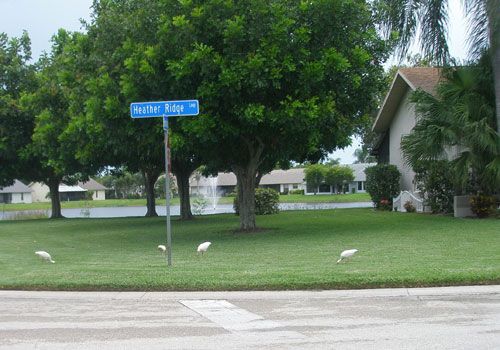
Credit: Max R. Crow Jr.
Economic Importance
Earthworms can have important indirect economic effects due to the ecological benefits outlined above. They make a healthier soil, which improves plant growth and agricultural productivity. For this reason worms are viewed as a gardener's friend and their presence and activity in gardens is generally encouraged (Figure 10).
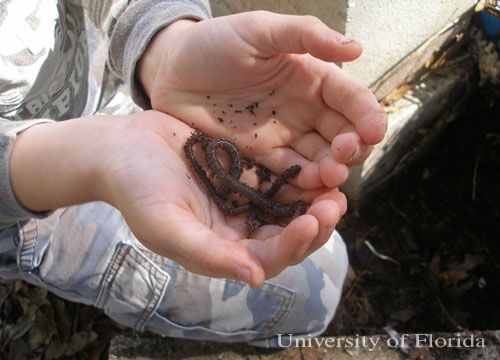
Credit: William T. Crow, UF/IFAS
Vermiculture is the science of commercial earthworm production. Certain species of earthworms are produced commercially for various reasons. Some of the commercial uses for earthworms worldwide are as fish food, a component in animal and poultry feed, and for human consumption. These worms are used unprocessed in some cases, but typically are dried and processed into meal that is blended with other food sources.
The primary commercial use for earthworms in Florida is as fish bait. There are many worm farms in Florida that supply worms to bait shops. In the Apalachicola National Forest, a cottage industry has evolved around the harvesting of a wild native earthworm Diplochardia mississippiensis for fish bait using the practice of "worm grunting" (Video on YouTube). Worm grunting uses seismic vibrations that result from scraping a wooden stake driven into the ground to force the worms to the surface. This practice is the highlight of an annual "worm gruntin' festival" in Sopchoppy, FL.
Vermicomposting is the practice of using earthworms, primarily epigeic species, to process organic wastes into useful castings. This is useful for reduction of animal (manure) waste, human food waste, yard waste, and paper/cardboard waste. The end result is vermicompost (compost composed of the worm castings) that is increasing in popularity as a horticultural soil amendment. Often vermicomposting and vermiculture go hand-in-hand with commercial sales of both the worms and the compost produced.
While not generally considered to be pests, earthworms can also have some negative economic impacts. Recently there has been concern that earthworms in the soil surrounding airstrips might attract birds that could damage airplanes. Similarly, earthworms in lawns or golf courses attract predators such as armadillos, moles, feral swine, and some birds that can damage turf while they are excavating for worms (Figures. 11 and 12). Earthworms are hosts for cluster fly larvae, whose adult stages are household nuisance pests. Worm castings on golf courses (Figure 13) can damage grass, dull mower blades, and deflect golf balls.

Credit: Joseph M. Schaefer, UF/IFAS
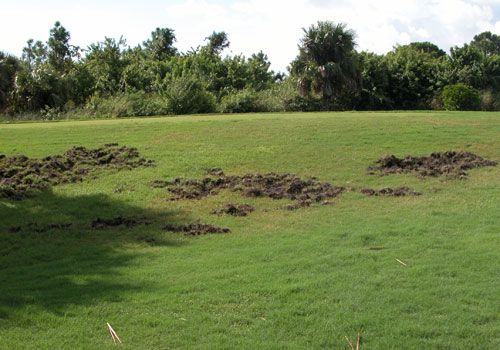
Credit: John H. Foy, USGA
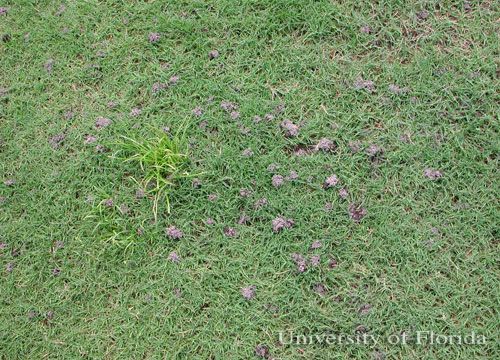
Credit: Eileen A. Buss, UF/IFAS
Management
Saponins are natural occurring soaps found in many plants. Research has shown that application of saponin-containing tea seed meal is very effective at reducing worm castings on golf course turf. Tea seed meal is a major component of at least one commercial organic turf fertilizer. Several turfgrass pesticides used for management of insects, nematodes, or fungi are known to negatively affect earthworms as well. However, no pesticides are currently labeled for use on earthworms.
Selected References
Catania, KC. 2008. Worm grunting, fiddling, and charming-humans unknowingly mimic a predator to harvest bait. PLos ONE 3:e3472.
Edwards, CA, Bohlen, PJ. 1996. Biology and Ecology of Earthworms, 3rd ed. New York, NY: Chapman and Hall.
Edwards, CA, Arancon NQ, Sherman R. 2011. Vermiculture Technology. Boca Raton, FL: CRC Press.
Hendrix, PF. 1995. Earthworm Ecology and Biogeography. Boca Raton, FL: Lewis Publishers.
Jamieson, BGM. 1988. "On the phylogeny and higher classification of the Oligochaeta." Cladistics 4: 367–410.
Potter, DA, Redmond CT, Meepagala KM, Williams DW. 2009. "Managing earthworm casts (Oligochaeta: Lumbricidae) in turfgrass using a natural byproduct of tea oil (Camellia sp.) manufacture." Pest Management Science 66: 439–446.
Reynolds, JW. 1994. "Earthworms of Florida (Oligochaeta: Acanthodrilidae, Eudrilidae, Glossoscolecidae, Lumbricidae, Megascolecidae, Ocnerodrilidae, Octochaetidae, and Sparganophilidae)." Megadrilogica 5: 125–141.
Sims, RW, Gerard BM. 1985. Earthworms. Bath, UK: The Pitman Press.